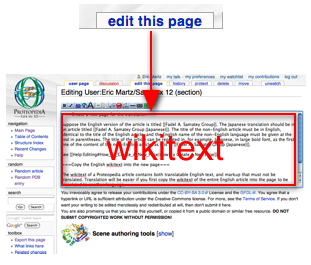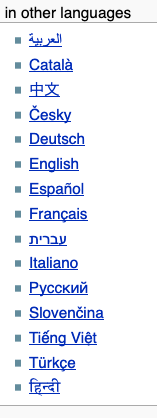User:Eric Martz/Sandbox 12: Difference between revisions
Eric Martz (talk | contribs) |
Eric Martz (talk | contribs) |
||
| Line 66: | Line 66: | ||
===Save Early And Often=== | ===Save Early And Often=== | ||
By mistake, you might change some markup characters. When you save the page, the display will be broken. If you have changed many lines of wikitext, you may not be able to find where the markup is broken. (In that case, please stop and email for help, {{Template:Contact}}. | By mistake, you might change some markup characters. When you save the page, the display will be broken. If you have changed many lines of wikitext, you may not be able to find where the markup is broken. (In that case, please stop and email for help, {{Template:Contact}}.) | ||
Please make one small change at a time -- one markup or one sentence. Then save and be sure the display is OK. If it is broken, you will know where the problem is. | Please make one small change at a time -- one markup or one sentence. Then save and be sure the display is OK. If it is broken, you will know where the problem is. | ||
Revision as of 11:21, 23 May 2011
Proposed article title: Help:Language Translation
This article offers a guide for how to translate an article (a page) in Proteopedia to another language, for example from English to Japanese. The main language of Proteopedia is English. There are no plans to have complete Proteopedias in non-English languages. (In contrast, Wikipedia maintains complete versions in many languages.) However, translation of English articles in Proteopedia to non-English languages is welcomed.
Of course, the English and non-English versions of an article will likely diverge, unless, whenever one article is edited, a volunteer updates the other article. While such divergence is undesirable, the problem divergence creates is considered to be outweighed by the value of having some articles in non-English languages.
PreparationPreparation
Create a new page for the translationCreate a new page for the translation
Suppose the English version of the article is titled Fadel A. Samatey Group. The Japanese translation should be in an article titled Fadel A. Samatey Group (Japanese). The title of the non-English article must be in English, identical to the title of the English article, and the English name of the non-English language must be given at the end in parentheses. The title of the article can be repeated in, for example, Japanese, in large bold font, as the first line of the content of the non-English article, as it is in Fadel A. Samatey Group (Japanese).
Translate the title of the pageTranslate the title of the page

The wikitext of a Proteopedia article is the editable text and markup that appears in the box after you click the tab edit this page (see image at right).
Delete everything in the wikitext box of your new page.
In the new page, put a translation of the English title inside the wikitext box, at the top. Use markup that will make the translated title large and bold. See the example at Fadel A. Samatey Group (Japanese). There, click edit this page, then copy the first line of this page into your new page.
Replace the Japanese in the copied line with the translation of the title of your page.
Mark the translation as being available in EnglishMark the translation as being available in English
Included at the end of the title line that you copied above is markup that specifies that this page is available in English:
- [[en:Fadel A. Samatey Group]]
Change the black part of the above markup to the name of the page in a different language. Do not change any of the red parts.
This markup does not show on the page. Rather, it generates a link to the other page at the left bottom, below the toolbox, like this:
For a highly-translated page, 1eve, it looks like this:
Save the page and test the in other languages link to make sure it works. If it goes to the Main Page, or the wrong page, then you need to correct the title of the page in the markup.
2-Letter Language Codes2-Letter Language Codes
Here is a link to a list of the two-letter codes for 184 languages. The article Interlanguage Links explains this markup, and the article ISO 639 has links to additional information and language lists.
Copy the English wikitext into the new pageCopy the English wikitext into the new page
The wikitext of a Proteopedia article contains both translatable English text, and markup that must not be translated. Translation will be easier if you first copy the wikitext of the entire English article into the page to be translated to another language. For this procedure we'll use the example of translation from English to Japanese.
- At the English page, click the tab edit this page. You will see the wikitext.
- Click in the wikitext box.
- Edit, Select All.
- Edit, Copy.
- Open the Japanese page in another browser tab or window.
- Click the tab edit this page.
- Place the cursor in the wikitext box where the English text and markup to be translated should be pasted, for example, below the Japanese title in the wikitext box.
- Edit, Paste.
- Save the Japanese page.
TranslationTranslation
Plain text can be translated. It is important not to translate markup.
Save Early And OftenSave Early And Often
By mistake, you might change some markup characters. When you save the page, the display will be broken. If you have changed many lines of wikitext, you may not be able to find where the markup is broken. (In that case, please stop and email for help, ![]() .)
.)
Please make one small change at a time -- one markup or one sentence. Then save and be sure the display is OK. If it is broken, you will know where the problem is.
Markup ExamplesMarkup Examples
Be careful not to translate markup. Here are some examples. The red must not be translated. The black needs to be translated. If you have any questions, please feel free to email ![]() .
.
- [[User:Fadel A. Samatey|Fadel A. Samatey]]
- [http://www.oist.jp/en/research/research-units/unit-transmem-traffick.html Transmembrane Trafficking Unit]
- [[en:Fadel A. Samatey Group]]
CompletionCompletion
Link the Translation to the Source ArticleLink the Translation to the Source Article
1. Put the interlanguage link markup at the top of the source article, indicating the new language in the translated article.
2. You may also wish to put a link in the new language, to the translated article, at the top of the English article. For an example, see Fadel A. Samatey Group.

